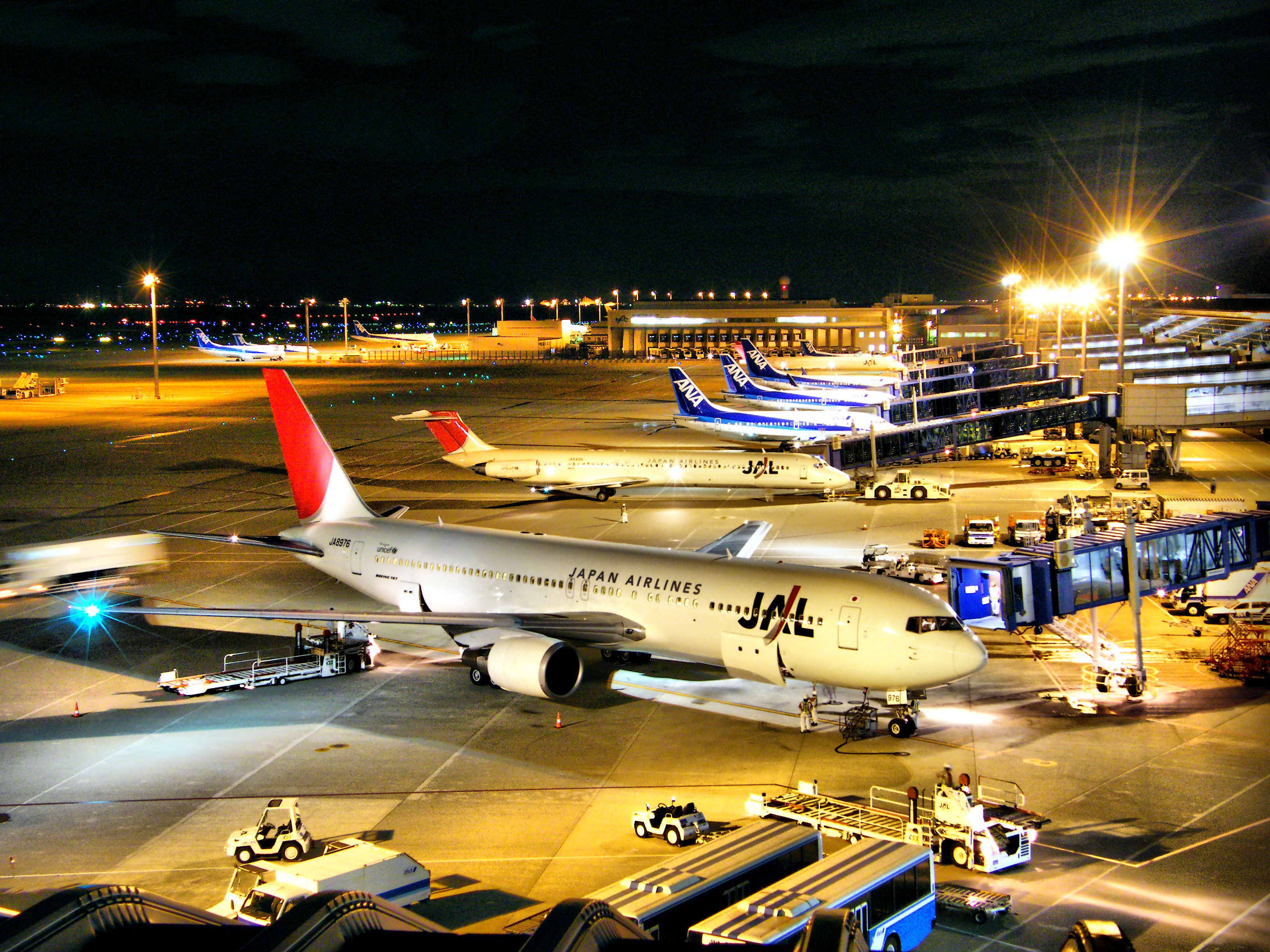|
Meitetsu Gifu Station
is a railway station located in the city of Gifu, Gifu Prefecture, Japan, operated by the private railway operator Meitetsu. It is one of the two major railway stations of the city along with JR Gifu Station. Lines Meitetsu Gifu Station is the terminal station for the Meitetsu Nagoya Main Line, and is 99.8 kilometers from the opposing terminus at . It is also a terminus for the 17.6 kilometer Meitetsu Kakamigahara Line. Station layout Entrance to the platforms Meitetsu Gifu Station has three island platform arranged in a "V"-shape. Platforms 1-4 are elevated, and serve the Nagoya Main Line, and also onward service for trains of the Meitetsu Takehana Line and Meitetsu Hashima Line. Platforms 5-6 is on the ground-level, and serves the Kakamigahara Line and onward service for trains of the Meitetsu Inuyama Line. Adjacent stations History The rail line originally opened on February 11, 1911, as the Nagazumi-cho Station; at the time, it was operated by the Mino ... [...More Info...] [...Related Items...] OR: [Wikipedia] [Google] [Baidu] |
Terminal Station
A train station, railway station, railroad station or depot is a railway facility where trains stop to load or unload passengers, freight or both. It generally consists of at least one platform, one track and a station building providing such ancillary services as ticket sales, waiting rooms and baggage/freight service. If a station is on a single-track line, it often has a passing loop to facilitate traffic movements. Places at which passengers only occasionally board or leave a train, sometimes consisting of a short platform and a waiting shed but sometimes indicated by no more than a sign, are variously referred to as "stops", "flag stops", " halts", or "provisional stopping places". The stations themselves may be at ground level, underground or elevated. Connections may be available to intersecting rail lines or other transport modes such as buses, trams or other rapid transit systems. Terminology In British English, traditional terminology favours ''railway station'' ... [...More Info...] [...Related Items...] OR: [Wikipedia] [Google] [Baidu] |
Railway Stations In Japan Opened In 1911
Rail transport (also known as train transport) is a means of transport that transfers passengers and goods on wheeled vehicles running on rails, which are incorporated in tracks. In contrast to road transport, where the vehicles run on a prepared flat surface, rail vehicles (rolling stock) are directionally guided by the tracks on which they run. Tracks usually consist of steel rails, installed on sleepers (ties) set in ballast, on which the rolling stock, usually fitted with metal wheels, moves. Other variations are also possible, such as "slab track", in which the rails are fastened to a concrete foundation resting on a prepared subsurface. Rolling stock in a rail transport system generally encounters lower frictional resistance than rubber-tyred road vehicles, so passenger and freight cars (carriages and wagons) can be coupled into longer trains. The operation is carried out by a railway company, providing transport between train stations or freight customer faciliti ... [...More Info...] [...Related Items...] OR: [Wikipedia] [Google] [Baidu] |
Chūbu Centrair International Airport
is an international airport on an artificial island in Ise Bay, Tokoname City in Aichi Prefecture, south of Nagoya in central Japan. Centrair is classified as a first class airport and is the main international gateway for the Chubu ("central") region of Japan. The name is an abbreviation of Central Japan International Airport, an alternate translation used in the English name of the airport's operating company, . 10.2 million people used the airport in 2015, ranking 8th busiest in the nation, and 208,000 tons of cargo was moved in 2015. History Chubu Centrair serves the third largest metropolitan area in Japan, centered around the city of Nagoya. The region is a major manufacturing centre, with the headquarters and production facilities of Toyota Motor Corporation and production facilities for Mitsubishi Motors and Mitsubishi Aircraft Corporation. With much lobbying by local business groups such as Toyota, especially for 24-hour cargo flights, construction started ... [...More Info...] [...Related Items...] OR: [Wikipedia] [Google] [Baidu] |
Meitetsu Inuyama Line
The is a 26.8 km Japanese railway line operated by the private railway operator Nagoya Railroad (Meitetsu), which connects Biwajima Junction in Kiyosu, Aichi with Shin-Unuma Station in Kakamigahara, Gifu. Together with the Kakamigahara Line, the line forms an alternate route of the Nagoya Main Line between Higashi-Biwajima and Meitetsu Gifu. Stations (L) (S) (E) (R) (LE) (RL) (MU) All trains stop at stations marked "●" and pass stations marked ", ". Some trains stop at "▲". History The Nagoya Electric Railway (later Meitetsu) opened the Biwajima to Iwakura section, as an interurban electrified at 600 V DC, in 1910. The line was extended to Inuyama in 1912 built with double tracks. In 1922, the Biwajima to Iwakura section was double-tracked, and in 1926, the line was extended as dual track to Shin-Unuma, including a combined rail and road bridge over the Kisogawa. In 1948, the voltage was increased to 1,500 V DC, and in 1993 through services comme ... [...More Info...] [...Related Items...] OR: [Wikipedia] [Google] [Baidu] |
Meitetsu Hashima Line
The is a Japanese railway line entirely within Hashima, Gifu Prefecture. It is owned by Nagoya Railroad (Meitetsu), and operated as an extension of the Takehana line, providing a connection to the Tokaido Shinkansen at Gifu-Hashima Station is a railway station on the Tokaido Shinkansen located in the city of Hashima, Gifu, Japan, operated by Central Japan Railway Company (JR Central). It is the sole Shinkansen station in Gifu Prefecture. Lines Gifu-Hashima Station is served only .... History Proposed in 1962, land acquisition difficulties prevented construction starting until 1978, and the line opened in 1982. Stations External links * References This article incorporates material from the corresponding article in the Japanese Wikipedia {{Nagoya transit Rail transport in Gifu Prefecture Hashima Line Railway lines opened in 1982 1067 mm gauge railways in Japan 1982 establishments in Japan ... [...More Info...] [...Related Items...] OR: [Wikipedia] [Google] [Baidu] |
Meitetsu Takehana Line
The is a Japanese railway line connecting Kasamatsu with Hashima within Gifu Prefecture. It is owned and operated by Nagoya Railroad (Meitetsu). History What is today the Meitetsu Takehana Line started when opened the section of line from Shin-Kasamatsu (now Nishi-Kasamatsu) to Shin-Sakae (now Takehana) on June 25, 1921, electrified at 600 VDC. On April 1, 1929, the line was extended from Shin-Sakae to . Takehana Railroad merged with Meitetsu, the present operator, on March 1, 1943. The voltage was increased to 1500 VDC in 1962, and in 1982 the Hashima line opened. On October 1, 2001, the section of line between Egira Station is a railway station located in the city of Hashima, Gifu Prefecture, Japan, operated by the private railway operator Meitetsu. Lines Egira Station is a station on the Hashima Line and the Takehana Line, and is located 10.3 kilometers from ... and Ōsu Station closed. Stations It is described in conjunction with the Hashima line. Refer ... [...More Info...] [...Related Items...] OR: [Wikipedia] [Google] [Baidu] |
Island Platform
An island platform (also center platform, centre platform) is a station layout arrangement where a single platform is positioned between two tracks within a railway station, tram stop or transitway interchange. Island platforms are popular on twin-track routes due to pragmatic and cost reasons. They are also useful within larger stations where local and express services for the same direction of travel can be provided from opposite sides of the same platform thereby simplifying transfers between the two tracks. An alternative arrangement is to position side platforms on either side of the tracks. The historical use of island platforms depends greatly upon the location. In the United Kingdom the use of island platforms is relatively common when the railway line is in a cutting or raised on an embankment, as this makes it easier to provide access to the platform without walking across the tracks. Advantages and tradeoffs Island platforms are necessary for any station with many th ... [...More Info...] [...Related Items...] OR: [Wikipedia] [Google] [Baidu] |
Meitetsu Kakamigahara Line
The is a 17.6 km railway line in Gifu Prefecture, Japan, operated by the private railway operator Nagoya Railroad (Meitetsu), connecting Meitetsu-Gifu Station in the city of Gifu with Shin-Unuma Station in Kakamigahara. Stations L: E: R: ● MU: History The line was opened between 1926 and 1927 by the Mino Electric Railway, electrified at 600 V DC. The company merged with Meitetsu in 1935. The Gifu to Ogase section was double-tracked between 1938 and 1942, with the Ogase to Shin-Unuma section being double-tracked in 1964, the same year the voltage was increased to 1,500 V DC, enabling the maximum speed on the line to be raised from 65 km/h to 85 km/h. Former connecting lines A 1 km line branched off at Tagami Station, providing a connection to the Gifu Tram network (which was also 1,067 mm gauge) operated between 1970 and 2005 (when the tram system closed). It changed voltage (with a short dead section) to 600 V DC at the Keirinjo-mae end of the line. {{Nagoya tr ... [...More Info...] [...Related Items...] OR: [Wikipedia] [Google] [Baidu] |
Gifu Station
is a railway station in the heart of the city of Gifu, Gifu Prefecture, Japan, operated by Central Japan Railway Company (JR Central). Lines Gifu Station is served by the JR Central Tōkaidō Main Line, and is located 396.3 kilometers from the official starting point of the line at . It is also the terminal station for the Takayama Main Line. Along with Nishi-Gifu Station and Nagamori Station, it is one of the three JR Central stations in the city of Gifu. Station layout The station consists of three elevated island platforms serving six tracks for the Tōkaidō Main Line and Takayama Main Line, with the station building underneath. The station has a ''Midori no Madoguchi'' staffed ticket office.JR Central Gifu Station information JR Central. Accessed December 5, 2007. Platforms < ...[...More Info...] [...Related Items...] OR: [Wikipedia] [Google] [Baidu] |
Meitetsu Logomark 2
, referred to as , is a private railway company operating around Aichi Prefecture and Gifu Prefecture of Japan. Some of the more famous trains operated by Meitetsu include the ''Panorama Car'' and the '' Panorama Car Super'', both of which offer views through their wide front windows. While the ''Panorama Super'' train is used extensively for the railroad's limited express service, the older and more energy-consuming ''Panorama Car'' train has been retired, the last run being on 27 December 2008. In the Tōkai region around Nagoya, it is a central firm of the Meitetsu Group, which is involved in the transportation industry, the retail trade, the service industry, and the real estate industry, etc. Meiji Mura is the corporate museum of Meitetsu. As of March 31, 2010, Meitetsu operated of track, 275 stations, and 1,090 train cars. Lines Major stations Major stations in Nagoya *NH36 : Meitetsu Nagoya Station *NH34 : Kanayama Station *NH33 : Jingū-mae Station *ST01 ... [...More Info...] [...Related Items...] OR: [Wikipedia] [Google] [Baidu] |

.jpg)





